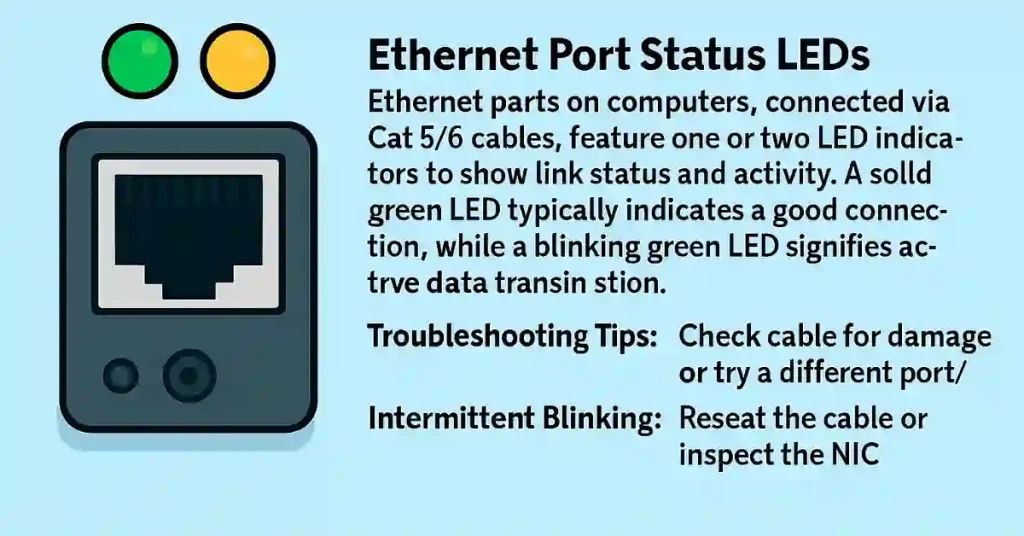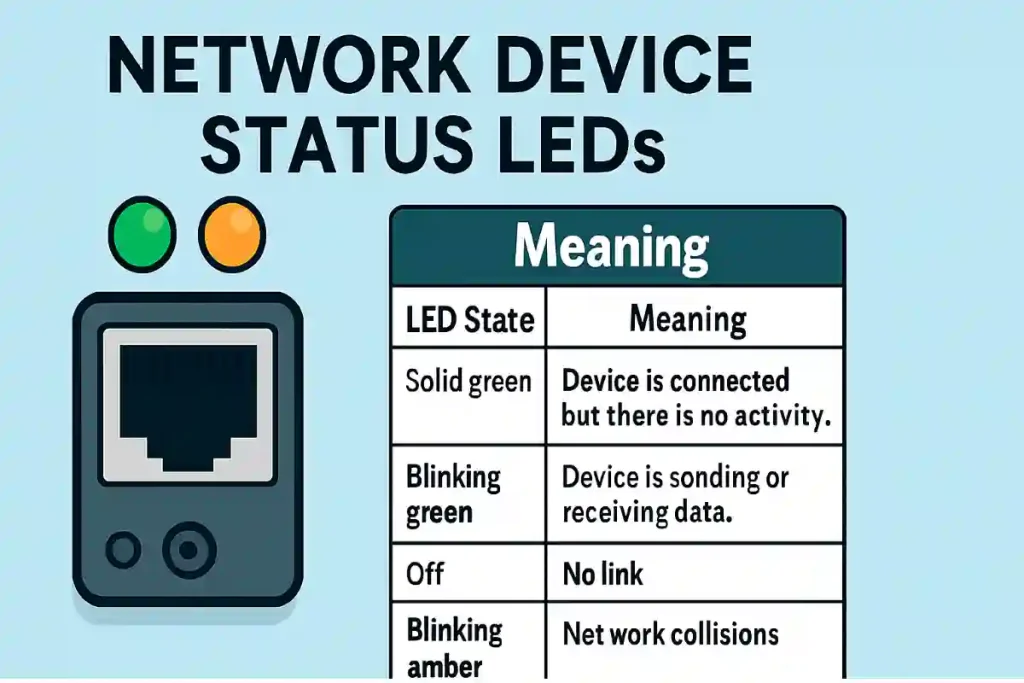Device status LEDs are essential tools for CCNA and CCNP students, offering quick visual cues to diagnose network issues. These indicators on NICs, hubs, routers, and switches help troubleshoot connectivity, performance, and faults efficiently. This article explores common LED meanings, Cisco-specific indicators, and practical tips to master network monitoring for certification and real-world success.
Ethernet Port Status LEDs
Ethernet ports on computers, connected via Cat 5/6 cables, feature one or two LED indicators to show link status and activity. A solid green LED typically indicates a good connection, while a blinking green LED signifies active data transmission.
Troubleshooting Tips
- No Light: If the LED is off, check the cable for damage or try a different port/cable. Use a cable tester if available.
- Intermittent Blinking: May indicate loose connections; reseat the cable or inspect the NIC.
- Reference Table: See the Updated Cisco Interface LED Indicators Table for detailed meanings.

Updated Cisco Interface LED Indicators Table
| LED Position | Color | Function Description |
|---|---|---|
| Left LED | Green / Amber / Off | Speed Indicator — Green: 1000 Mbps (Gigabit), Amber: 100 Mbps, Off: 10 Mbps or inactive |
| Right LED | Green (Blinking / Off) | Link Activity Indicator — Blinking: Active traffic, Off: No link established |
Network Device Status LEDs
Network devices like hubs, switches, and routers feature multiple LEDs on their front panels, providing a snapshot of system health for administrators. Cisco Catalyst switches, for instance, use status LEDs that glow solid green during normal operation and amber to indicate malfunctions.
Cisco-Specific Examples
- Catalyst 2950 Switch: A solid green “System” LED shows power-on, while a blinking amber signal indicates a boot failure.
- ISR Router: The “VPN” LED blinks green during VPN activity; off indicates no VPN session.
- General Guideline: Consult device-specific manuals (e.g., Cisco Catalyst 9000 Series) for exact meanings.
Cisco Device LED Status Table
| LED State | Meaning |
|---|---|
| Solid green | Device is actively sending or receiving data |
| Blinking green | Normal activity (e.g., data transmission) |
| No LED lit | No link — check cable, power, or port status |
| Blinking amber | Network collision or fault; investigate |
| Solid amber | Malfunction or PoE issue (device-specific) |
Troubleshooting with LEDs
LED indicators guide network troubleshooting by highlighting issues. Use these steps to address common problems based on LED states.
Common Scenarios
No LED Lit:
- Action: Verify cable connections, ensure the device is powered, and check the port status with
show interface statuson Cisco devices.
Blinking Amber:
- Action: Investigate collisions by checking for faulty NICs or duplex mismatches using
show interface.
Solid Amber:
- Action: Check for PoE overload or hardware failure; reboot the device or consult Cisco documentation.
Tools
- Cable tester for physical layer issues.
- Cisco commands:
show port statusorshow logfor detailed diagnostics.
Conclusion
Understanding device status LEDs is a vital skill for CCNA and CCNP students, enabling rapid network troubleshooting and maintenance. This article has covered Ethernet ports and Cisco device LED meanings, with practical troubleshooting tips. Practice interpreting LEDs in Packet Tracer labs or real Cisco devices to excel in exams and network operations.
Frequently Asked Questions (FAQs)
What does a green LED mean on a network device?
A solid green LED indicates a good connection or active data transmission on a port. Blinking green shows network activity, making it a key troubleshooting cue. Always check device manuals for specific meanings.
How can I troubleshoot a blinking amber LED?
A blinking amber LED signals network collisions or faults; check for faulty cables or NICs. Use Cisco’s show interface command to diagnose duplex or speed mismatches. Persistent blinking requires further investigation.
Why might a switch port LED be off?
An off LED suggests no link, possibly due to an unplugged cable, powered-down device, or administratively shut port. Verify connections and use show interface status to confirm. Replace cables if needed.
What do LED indicators on a Cisco ISR mean?
Cisco ISR LEDs provide status on power, VPN, and ports; green shows normal operation, amber indicates issues. Consult the ISR manual for exact meanings. Use show led or logs for detailed insights.
Can LEDs help with PoE troubleshooting?
Yes, a solid amber LED on PoE switches may indicate a power overload or device failure. Check PoE status with show power inline on Cisco devices. Adjust connected devices to resolve issues.





